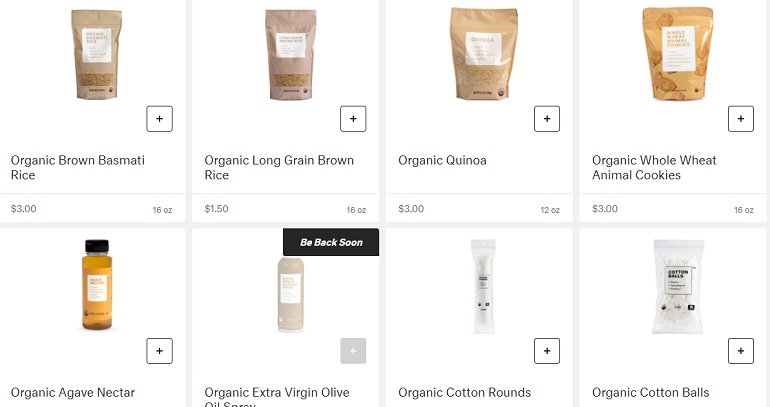A new e-commerce site sells better-for-you private label products for $3 apiece.

E-commerce grocery site Brandless exploded on the scene in July, thanks to its better-for-you product selection and its easy-on-the-wallet $3 price point. All the food is non-GMO, much of the selection is organic, and over 400 potentially harmful ingredients have been eliminated from its beauty offerings.
Here, chief merchant Rachael Vegas sheds light on the site’s supply chain, marketing strategy and wide reach.
How did you decide on $3 as the price point?
Rachael Vegas: Grocery shopping is a chore because it is overcomplicated by an immense amount of choice. We scaled down our assortment because you don't need 50 ketchups to choose from; you need one really good organic ketchup. Along these same lines, we didn’t want all different pricing—for example, having to navigate the difference between products with pricing ending in a nine versus something else. We wanted that to be straightforward, too.
What was the inspiration behind Brandless?
RV: A lot of retailers do private label, lots do better-for-you and some do ecommerce. But no one was doing all three exclusively. So there was this white space where we could meet an unmet consumer need. Seventy-seven percent of millennials don't want to buy the brands their parents buy, and 88 percent are interested in buying private label. Plus, the time was right. Coming out of the Occupy movement, and with all the changes happening in this country, the people deserve better. We want to provide people with better quality products and make it accessible to everyone.
How do you keep your prices low and your quality high?
RV: We coined a term called “brand tax” and we consider that to be, in its simplest form, the premium you pay for branded versus unbranded products. What drives this brand tax? It’s the complexity of the supply chain.
What makes organic products so expensive is, first, supply and demand, but more importantly, the people making it have to create a brand, market that brand, identify a distributor to get that brand into stores, find a broker to get it in front of the merchants, and then in the store you have labor and inventory costs. All that adds up. There's a lot of complexity in the supply chain that we've eliminated. We go right from our manufacturer to our consumer.
How are your products different than other store brands?
RV: In some cases, like with a single-ingredient item, organic black beans are organic black beans. Nothing is unique there. But if you look at our snacking, beauty or cleaning assortment, it's a lot more innovative. We’ve created unique items in partnership with our vendors. It's not necessarily something you'd find in every store.
Great product is king. So taste, efficacy, function—that is going to be of utmost importance. But there doesn't have to be a trade-off on what's important to you and what you can afford. With Brandless, you can have what you think is most important for your body and home, and get a great value when you're buying that, and feel good about it. Part of that feeling good is that, with every order, we give a meal to Feeding America.
What is your marketing plan? How do you brand the brandless?
RV: This is an existential problem. We are unapologetically a brand; we are just redefining what it is to be a brand. We aren't spending a ton of time on color and graphics and the expenses associated with the package. Instead, we’ve used our white box to convey the key attributes that matter to consumers about that product. Those attributes are different on toothpaste, dish soap and mayonnaise. So that is a huge piece of our marketing. We’re telling people up front and on package, what do you care about as it relates to these items, and this is what we can share with you.
As far as getting the word out, we consider Brandless to be a movement as much as a brand. Our target markets are on Instagram and Twitter, and we are creating a relationship with those customers. The response rate is astounding. We thought we’d be huge with urban millennials, but all 48 contiguous states are buying. They often don't have access in rural America to better-for-you products. They don't have a Trader Joe's or Whole Foods Market on every corner. They are constrained by what they have access to, and Brandless offers them something new.
About the Author(s)
You May Also Like


